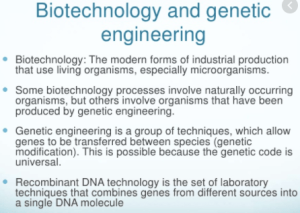Biology
Biotechnology and genetic engineering: Differences and Applications

Biotechnology is the study of the use of technology to modify organisms, cells, etc for the benefits of human beings, while genetic engineering is the advanced technique of biotechnology in which genes of an organism are modified, replaced, and replaced. It is also known as genetic modification.
Now!
We learn in detail about biotechnology and genetic engineering.
Keep reading…..
What is BIOTECHNOLOGY?
Biotechnology is the use of biological processes performed with the help of microorganisms to make useful substances (e.g. penicillin) or to provide special services to man.
- The man has been using similar techniques since ancient times. The ability of microorganisms to carry out fermentation to produce foods such as bread. cheese, yogurt, and wine, the selective breeding of horses, dogs, cows, etc. special breeds of crops and synthesis of vaccines are examples of biotechnology.
What is GENETIC ENGINEERING?
Genetic engineering is a technique used to transfer genes from one organism to another.
- Genetic engineering helps in the substitution of desirable genes in place of unwanted genes and the malfunctioning genes with the healthy and functional genes.
- These transgenic organisms are serving mankind by producing pharmaceutical products like enzymes and hormones by producing more nutritious plants and by creating bigger and heavier fish, poultry, and cattle for human consumption.
Process
- Individual genes may be cut off from the cells of one organism and inserted into the cells of another organism of the same or different species. The transferred gene can express itself in these genetically engineered organisms. The organism may then make the protein for which the inserted gene codes. Transgenic bacteria w h make human insulin are an example of genetic engineering.
- The potential of genetic engineering is enormous. It has large scale applications in agriculture, in chemical and in drug industries. Through genetic engineering has many advantages, it is not without hazards.
Describe some of the useful uses of bacteria and fungi?
1) FERMENTATION
- Synthesis of many useful food products by the help of bacteria and fungi like yeast is called fermentation.
For Example
- Yogurt is made by fermenting milk, using certain bacteria.
- By varying conditions such as temperature and using different bacteria and fungi. Different types of cheese can be produced.
- For the production of wine, yeast is mixed with sugar, found in food substance. in brewing barley, grapes, etc.
2) SYNTHESIS OF ANTIBIOTICS
- Antibiotics like penicillin arc complex substances produced by microorganisms as the by-products. They arc efficient drugs to cure many bacterial diseases.
3) SYNTHESIS OF PROTEIN
- Many bacteria and yeast produce single CDL proteins (SCI’) which are rich in vitamins and used as food.
4) USE OF YEAST IN BREAD MAKING
- The flour used in making bread contains starch, protein, and enzyme amylase. the hour is mixed with water to form a dough and yeast is then added.
- Amylase breaks the starch into sugar. Lack of oxygen inside the dough causes the yeast to respire aerobically, fermenting the sugar to alcohol and carbon dioxide making cavities appear in the bread. The alcohol produced evaporates during baking.
5) BACTERIA AND FUNGI IN SOIL AS DECOMPOSERS OF ORGANIC MATTER
- Saprotrophic organisms mainly bacteria and fungi are decomposers. Organic material incorporates into the bodies of consumers is essentially broken down after their death into inorganic materials by the decomposer. These inorganic compounds are then rebuilt into organic compounds by the synthesizing activities of the producers It is thus evident that matter circulates in nature and though it constantly changes its form there is no overall loss or gain.
- Decomposers arc the extremely important. components of this recycling business. They help to release substances of the bodies of dead organisms hack into an environment wherefrom they can be used again by living ones. Two of these important substances arc carbon and nitrogen.
- Carbon
- Being an essential part of carbohydrates, fats, and proteins, carbon is a very important component of living things. When the plants or animals die and decomposers feed on them. the carbon becomes part of the decomposer’s bodies. When they respire. they release carbon dioxide into the air again.
- Nitrogen
- Living things need nitrogen to make proteins. Although the air is rich in nitrogen, it is in such an un-reactive form that plants and animals cannot use it all. It is, therefore. Changed into a more reactive form such as ammonia (NH.) or nitrates (NO3) changing nitrogen gas into more reactive form, is called nitrogen-fixing, Nitrogen-fixing bacteria in soil and In leguminous plants
- These bacteria live in soil or in root nodules (small swellings) of plants like peas, beans, and clover, etc. One of its kinds Is called Rhizobium (rhino means root, bean means living). They use nitrogen gas present in the soil with other substances to convert it into nitrates and other reactive forms.